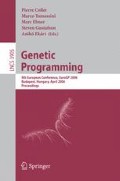Abstract
This paper extends a geometric framework for interpreting crossover and mutation [4] to the case of sequences. This representation is important because it is the link between artificial evolution and biological evolution. We define and theoretically study geometric crossover for sequences under edit distance and show its intimate connection with the biological notion of sequence homology.
Access this chapter
Tax calculation will be finalised at checkout
Purchases are for personal use only
Preview
Unable to display preview. Download preview PDF.
References
Gusfield, D.: Algorithms on Strings, Trees and Sequences. Cambridge University Press, Cambridge (1997)
Moraglio, A., Poli, R.: Geometric landscape of homologous crossover for syntactic trees. In: Proceedings of CEC 2005, pp. 427–434 (2005)
Moraglio, A., Poli, R.: Topological crossover for the permutation representation. In: Workshop on theory of representations at GECCO (2005)
Moraglio, A., Poli, R.: Topological interpretation of crossover. In: Deb, K., et al. (eds.) GECCO 2004. LNCS, vol. 3102, pp. 1377–1388. Springer, Heidelberg (2004)
Jones, T.: Evolutionary Algorithms, Fitness Landscapes and Search. PhD dissertation, University of New Mexico (1995)
Deza, M., Laurent, M.: Geometry of cuts and metrics. Springer, Heidelberg (1991)
Pardalos, P.M., Resende, M.G.C.: Handbook of Applied Optimization. Oxford University Press, Oxford (2002)
Platel, M.D., Clergue, M., Collard, P.: Maximum homologous crossover for linear genetic programming. In: Ryan, C., Soule, T., Keijzer, M., Tsang, E.P.K., Poli, R., Costa, E. (eds.) EuroGP 2003. LNCS, vol. 2610, pp. 194–203. Springer, Heidelberg (2003)
Kimura, M.: Neutral theory of molecular evolution. Cambridge University Press, Cambridge (1983)
Author information
Authors and Affiliations
Editor information
Editors and Affiliations
Rights and permissions
Copyright information
© 2006 Springer-Verlag Berlin Heidelberg
About this paper
Cite this paper
Moraglio, A., Poli, R., Seehuus, R. (2006). Geometric Crossover for Biological Sequences. In: Collet, P., Tomassini, M., Ebner, M., Gustafson, S., Ekárt, A. (eds) Genetic Programming. EuroGP 2006. Lecture Notes in Computer Science, vol 3905. Springer, Berlin, Heidelberg. https://doi.org/10.1007/11729976_11
Download citation
DOI: https://doi.org/10.1007/11729976_11
Publisher Name: Springer, Berlin, Heidelberg
Print ISBN: 978-3-540-33143-8
Online ISBN: 978-3-540-33144-5
eBook Packages: Computer ScienceComputer Science (R0)

